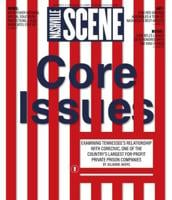
Metropolitik is a recurring column featuring the Scene’s analysis of Metro dealings.
Mayor Freddie O’Connell hopes to give Nashvillians a transportation answer this month. The release was initially slated for late March, but city officials have been going back and forth with hired consultants trying to nail down an accurate financial forecast for the city’s biggest transportation push since 2018.
Polling from Vanderbilt University and community coalition Imagine Nashville back up O’Connell’s bet on transit. Moving through Nashville was the now-mayor’s top campaign issue, matching the picture that emerges from survey respondents’ top ills (traffic, congestion, walkability) and top wants (improving public transportation). A lack of robust transit infrastructure and affordable housing have become the concrete consequences of a booming city without a plan to manage its growth. Administration executives Michael Briggs and Kendra Abkowitz lead the mayor’s public-facing efforts to gin up support among major city stakeholders, which have mainly taken place during biweekly meetings of O’Connell’s Technical and Community Advisory committees.
Pressure to get the plan — which requires direct voter approval — on the November ballot has dogged O’Connell since before he formally took office. Even before the plan’s official release, O’Connell has made public voters’ essential tradeoff: what you pay and what you get.
Transit improvements will secure dedicated funding from a 0.5 percent bump in Davidson County sales taxes, according to the administration. Interest rates, financing mechanisms and inflation all cloud the fiscal picture of what exactly that 0.5 percent sales tax bump could safely borrow for Nashville, the exact question the city is scrambling to answer before April 19. The city has indicated it will attempt to match local spending with state and federal dollars available to municipalities for infrastructure spending.
For at least a decade, O’Connell has raised the topic of dedicated transit funding in line with most other major cities. Dedicated funding matches a pledged money stream to transportation spending. This method is considered a more stable and predictable funding mechanism that avoids the need for year-by-year allocations, which is how Nashville funds WeGo today.
Categorized as a regressive tax because it imposes a flat cost on consumers regardless of income, the funding has already presented itself as a point of controversy in the plan.
“I was in Kroger the other day — there was a lady in front of me putting some things back,” Van Pinnock, a North Nashville resident and recently vacated TSU board member, told Briggs at a March 20 meeting of O’Connell’s Community Advisory Committee. “Her bill was $5 more than what she had. Five dollars doesn’t seem like a lot to us, but it’s a lot to a lot of families.”
“We want to deliberately talk about this and understand the impacts and some of the benefits gained by having a transit program too,” Briggs responded.
Mayor joins Technical Advisory Committee to discuss financing and direction ahead of planned transit release
Black voters and working-class voters swung against Let’s Move Nashville, the failed 2018 referendum carried by former Mayor Megan Barry. O’Connell’s advisory committees have consciously included Black community leaders like Pinnock. Sometimes they function like focus groups, providing feedback to Briggs and other mayoral staff. Other times, they’re treated like influencers with whom the administration is courting support ahead of a six-month campaign.
The sales tax bump would cost consumers an additional 50 cents for every $100 spent in the checkout line. In return, Nashville revamps sidewalks, traffic signals and buses. Maps released on March 14 give the clearest picture of countywide spending, which comes in three categories. Expanded bus service — the plan’s headline item — clears dedicated rapid transit lanes on Dickerson Pike, Murfreesboro Road, Nolensville Pike and Gallatin Avenue. The Murfreesboro service artery includes branches to the airport and into Antioch. The plan also includes increased service, but not full dedicated routes, down Charlotte Avenue, Clarksville Pike and a downtown loop. At a March 20 advisory committee meeting, Briggs said working plans include dedicated bus rapid transit lanes on West End Avenue, previously planned as a corridor where bus service was integrated into car traffic. This is one of a few small tweaks from planners since maps were first presented in a March 6 Technical Advisory Committee meeting.
Proposed sidewalks will accompany increased bus service on each major thoroughfare to enable pedestrian access to and between bus stops and transit centers. Concept maps detail 86 miles of sidewalk construction, including additions to the grid around Green Hills, Antioch, Bellevue and Donelson. Modernized traffic signals are the plan’s final pitch, a combination of updates and needed coordination that will help integrate expanded bus service.
KraftCPAs will review the plan for the city before referring it to the state comptroller for approval by May 31, a necessary step before a vote. The mayor would then file the plan to the Metro Council by June 7 for review in its own approval process. If everything stays on track, voters will see it on the Nov. 5 ballot. τ






